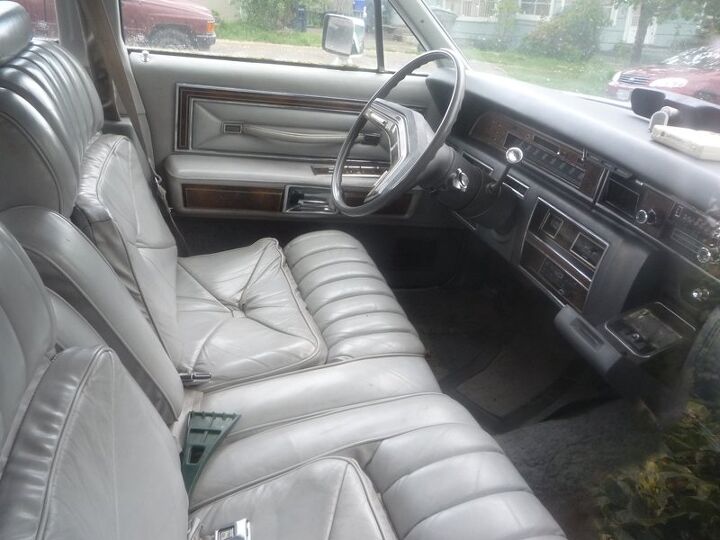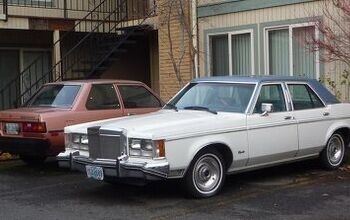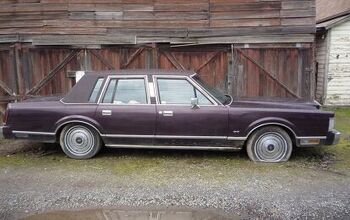Curbside Classic: 1977 Lincoln Town Car

Here it is, the last of the species autosaurus giganticus. Never again would beasts of this size roam our freeways and driveways with their EPA stickers (10/12) still freshly removed. It was the end of an era; the giant American land cruiser became extinct when the last 1979 Town Car rolled off the lines. And that last roll took a while: two hundred thirty three and seven-tenths inches of steel, chrome, vinyl and deeply tufted leather. No less than the visionary Buckminster Fuller, inventor of the geodesic dome and the very un-Town Car like Dymaxion Car lamented (and lambasted) the passing of the last big Lincoln. Given that he was all of 5’2″ tall, that seems a bit odd. But really big cars were such a part of the American psyche, that when they were gone, it left a gaping hole. You don’t miss your water ’till the well runs dry.
I may have mixed feelings about some of the other big old Lincolns, but these last Town Cars, from ’77-’79, were such bold survivors like the last Wooly Mammoths that roamed the earth, that I can’t help but be in (shock and) awe. The transplanted fake Rolls Royce-like grille from the Mark IV only added to their outrageous rebellion against the grain of the times. Cadillac and the rest of GM had dramatically downsized in 1977. Chrysler’s increasingly irrelevant big cars were gone after 1978. But Lincoln held out, for even one more year after its stablemates, the big Fords and Mercuries, had jumped into the hot wash cycle.
Lincoln finally hit the big volume jackpot in the mid-late seventies. This 1977 Town Car is one of almost 200k Lincolns produced that year, about eight times what the classic ’61 Continental sold at. There was still a healthy gap between it and Cadillac, but nothing like earlier days. The Mark III coupe had been a fairly successful extension of the line, and the Mark IV was a really BIG hit. Well, it was the blow out, before the crash. Downsizing these slabby Lincolns did not go over well, as we’ll see in our next installment.
These cars epitomized the changes that had taken place in the US since the early sixties. The “Kennedy Lincolns” reflected the sense of understated style and artistic sensibility that Jackie embodied. The cars were powerful and optimistic, and projected the ideals of the time. By the late seventies, these Lincolns were a place to hide from a much more complicated and frankly uglier world. Of course these Town Cars did nothing to make the world any prettier or less ambivalent.
With their ostentatious fake grilles, opera windows and other affectations, and their gas guzzling ways in the face of rising gas prices and environmental concerns, they were a 5,000 lb bundle of contradictions. But riding in the back of one was anesthetizing balm; much better that then actually driving one.
Any semblance of performance had long gone the way of suicide doors. The standard engine in this ’77 was reduced to the 400 cubic inch (6.6 liters) mid-block V8, with a mere 179 (net) hp. In 1978, that shrunk further to 166 hp. At least the 460 was still optional. But in its final year in ’79, only the 400 with now 159 hp was on tap. No wonder Lincoln was playing up all the “Designer Series” variations.
Givenchy, Pucci, Bill Blass, and even Cartier versions of Town Cars and Marks drove up prices and profits in ways that would foreshadow the big luxo-SUVs to come. Some of the final ’79 “Collector Series” Lincolns cost over $22k, almost double what a base TC started at. Make hay while the sun shines; or: there’s a sucker born every minute. Both apply equally, as well as a few other choice aphorisms. Blinged-out Navigators and Escalades were barely a generation away.
But the eighties were the transitional decade before that started in earnest. And Lincoln’s first steps into that decade were not a walk in the park. Leaving behind the familiarity of big cars, and transitioning to smaller ones was something GM pulled off fairly well the first go-around. Meanwhile, it seemed like Ford was being dragged into it, and it showed. That must be the reason Ford made so much hay with the last few years of the big Lincolns; they obviously didn’t have a lot of confidence in the clays sitting in their advanced styling studios.

More by Paul Niedermeyer
Latest Car Reviews
Read moreLatest Product Reviews
Read moreRecent Comments
- Theflyersfan OK, I'm going to stretch the words "positive change" to the breaking point here, but there might be some positive change going on with the beaver grille here. This picture was at Car and Driver. You'll notice that the grille now dives into a larger lower air intake instead of really standing out in a sea of plastic. In darker colors like this blue, it somewhat conceals the absolute obscene amount of real estate this unneeded monstrosity of a failed styling attempt takes up. The Euro front plate might be hiding some sins as well. You be the judge.
- Theflyersfan I know given the body style they'll sell dozens, but for those of us who grew up wanting a nice Prelude Si with 4WS but our student budgets said no way, it'd be interesting to see if Honda can persuade GenX-ers to open their wallets for one. Civic Type-R powertrain in a coupe body style? Mild hybrid if they have to? The holy grail will still be if Honda gives the ultimate middle finger towards all things EV and hybrid, hides a few engineers in the basement away from spy cameras and leaks, comes up with a limited run of 9,000 rpm engines and gives us the last gasp of the S2000 once again. A send off to remind us of when once they screamed before everything sounds like a whirring appliance.
- Jeff Nice concept car. One can only dream.
- Funky D The problem is not exclusively the cost of the vehicle. The problem is that there are too few use cases for BEVs that couldn't be done by a plug-in hybrid, with the latter having the ability to do long-range trips without requiring lengthy recharging and being better able to function in really cold climates.In our particular case, a plug-in hybrid would run in all electric mode for the vast majority of the miles we would drive on a regular basis. It would also charge faster and the battery replacement should be less expensive than its BEV counterpart.So the answer for me is a polite, but firm NO.
- 3SpeedAutomatic 2012 Ford Escape V6 FWD at 147k miles:Just went thru a heavy maintenance cycle: full brake job with rotors and drums, replace top & bottom radiator hoses, radiator flush, transmission flush, replace valve cover gaskets (still leaks oil, but not as bad as before), & fan belt. Also, #4 fuel injector locked up. About $4.5k spread over 19 months. Sole means of transportation, so don't mind spending the money for reliability. Was going to replace prior to the above maintenance cycle, but COVID screwed up the market ( $4k markup over sticker including $400 for nitrogen in the tires), so bit the bullet. Now serious about replacing, but waiting for used and/or new car prices to fall a bit more. Have my eye on a particular SUV. Last I checked, had a $2.5k discount with great interest rate (better than my CU) for financing. Will keep on driving Escape as long as A/C works. 🚗🚗🚗








































Comments
Join the conversation
I just bought a '78. 7.5 mpg in town. http://dbshootings.blogspot.com/2012/04/larger-and-in-charger.html
I have a pristine one of these - unlike the pictured one, I look after mine. Ice Blue Moondust, no vinyl roof (I had it removed), no opera windows, and a medium blue velour interior that looks new. A PA state Feb 1977 Town Car with the 460. It's my daily driver/commuter and an absolute joy to own and drive. I wish every trip was longer and arrive at every destination relaxed and soothed. It averaged about 6.5mpg city (I live in a big, congested city and work downtown) and barely reached 11 on a highway cruise, so I had it fully converted to LPG, and now its even better to drive. Smoother, and far cheaper to run. Am I able to post pictures here? Dermot